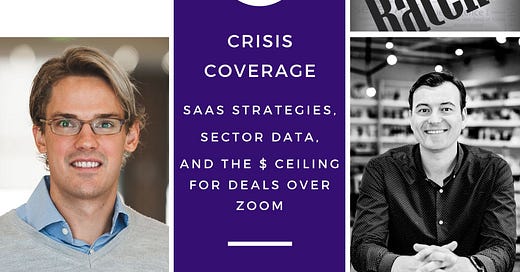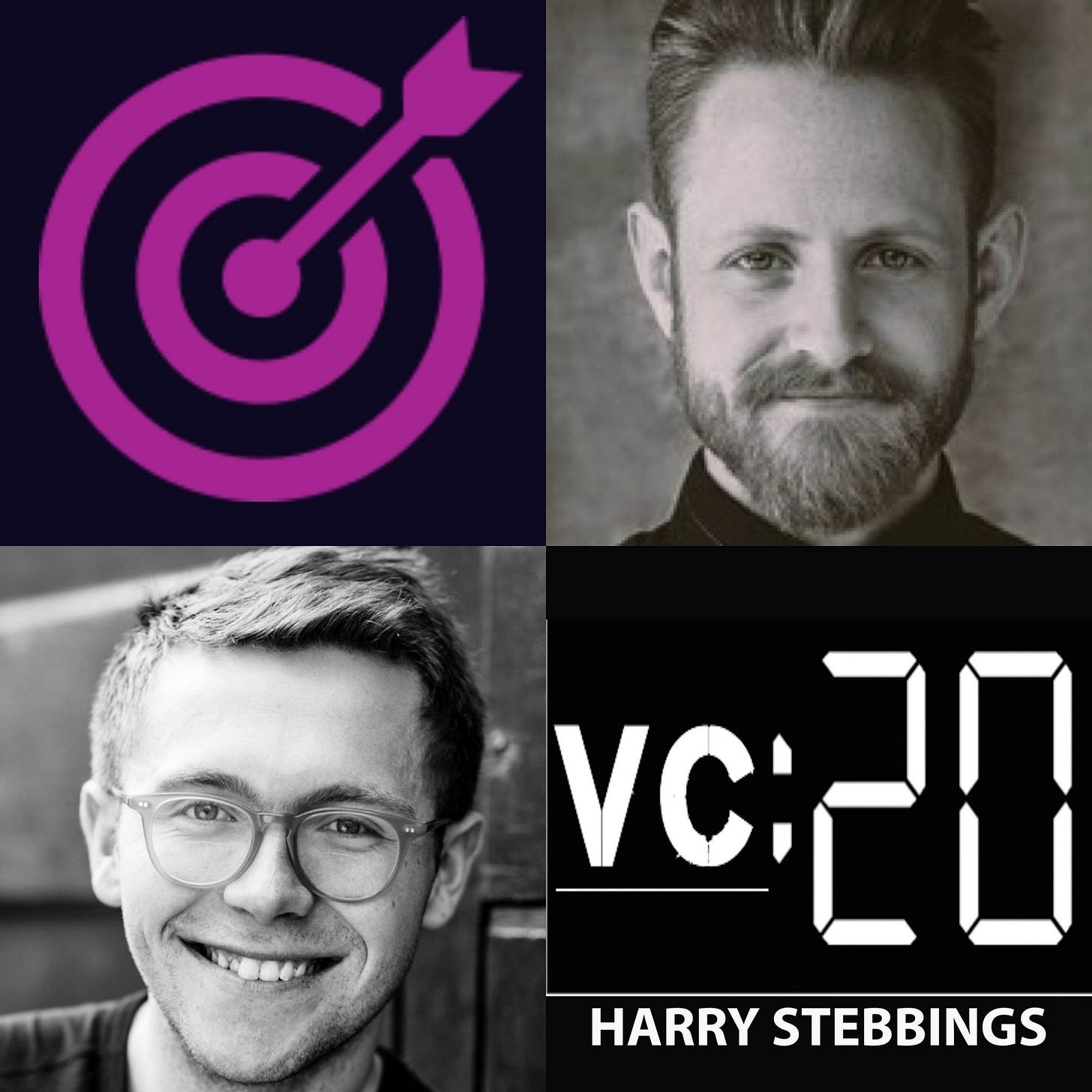“The first order of business is survival.” - Tomasz "Product is both an art and a science.” - Daniel
Tomasz Tunguz of Redpoint Ventures & Daniel Erickson the Founder & CEO @ Viable Fit


(April 27, 2020 - 29 minutes)
Tomasz Tunguz of Redpoint Ventures
The Full Ratchet: A podcast dedicated to demystifying Venture Capital. Nick Moran interviews the VC and Angel investor experts on how they find, evaluate and select the next generation of great technology start-ups.
THE INVESTING THESIS
Tomasz stands by his thesis to invest about 75% into B2B, 25% and B2C, and within the B2B world, half SAS and another half in infrastructure. However, he has been looking for more open source software at the application tier to acquire more customers as they penetrate infrastructure and platforms well.
THE BIGGEST CHANGE IN SaaS INVESTING
There is more competition with the valuations of SaaS companies being untouched in the public market due to their attractive dollar retention characteristics. Furthermore, there have been major product changes with an increasing focus on product-led, customer acquisition and bottom-up qualities. Another prominent change would be the increasing integration of cloud perm with larger companies wanting to control the cost of their software more.
THE TWO-BY-TWO DECISION MATRIX & GUIDANCE
Create two axes with the balance sheet is on one axis (i.e.: does it have little/a lot of capital?) and customer demand (i.e.: Is customer demand slow/ravenous?) on the other. If runway and customer demand is scarce, strive for profitability as soon as possible. Should there be abundant capital and customers, being aggressive where necessary will be fine. If there are many tasks but low customer demand, retool the product and reduce costs just enough to ensure the runway period. If there is high customer demand but no big balance sheet, focus on increasing the balance sheet.
HOW TO: VET STARTUPS BENEFITTING FROM THE CRISIS
Firstly, ask how long will the startup profit from the crisis and should it be more than two years, analyse if it could benefit from the fundraising environment. Next, decipher the valuation of the startup by determining the base rate and steady growth level. Whilst addressing these concerns, construct a mental model based on accelerating demand or demand acquisition to best move forward.
VETTING CRITERIA - ADJUSTING & ANALYSING
Tomasz himself has not adjusted his vetting criteria or expectations despite the global crisis. Instead, he increases his scepticism during the vetting process and continues asking questions such as ‘How would a company fare in recession’ and ‘Is the service/product on a high level of the priority stack for the buyer’. Net dollar retention, National Pensions System (NPS) and pipeline to quota ratio would be the less common factors to analyse.
THE MRR STANDPOINT
Concerning situations with an agreed MRR wherein the contract value is paid upfront, Tomasz personally enjoys both annual prepays and multi-year prepays. Moreover, he believes that the greater the fraction of the MRR is monthly, the higher the churn. This is due to the increased sales as customers are making a renewal decision 12 times a year as oppose to once a year.
ON CUSTOMER CONTRACTS & CLOSING DEALS OVER THE PHONE
In this new environment, it is important to have a long-term view and retain customer relationships. With a large balance sheet and the ability to handle the short-term cash flow impact, engender goodwill, spend time with customers to improve the product, broaden the product portfolio and entice good teams to join the cause. Likewise, Tomasz believes that there is no limit to the size of deals closed over the phone. Regardless of the contract size, the ability to generate confidence over the line is what matters most.
IMPACTED & ACCELERATED SECTORS
Sectors that have seen the most impacts are discretionary spend B2C sectors (i.e.: travel and fitness) and RPA with more meaningfully cut expenditures as well as license rationing. Lagging effects are prominent in SAP related sectors due to slow upgrades and optimisation of heavy software. However, e-Commerce, machine learning infrastructures, artificial intelligence and SaaS sectors have been benefitting enormously. Non-obvious areas that will acquire a big boost are cloud infrastructure and connectivity as they are viewed as cost-cutting, modernising efforts.
20VC: How To Scientifically Measure Product-Market Fit, How To Efficiently and Accurately Segment Users Into Cohorts, Why Investors Analysing CAC's at Pre-Seed Is Not Useful & How To Determine Between Customer Feedback to Accept vs Reject with Daniel Eric
(June 5, 2020 - 26 minutes)
Daniel Erickson is the Founder & CEO @ Viable Fit
The Twenty Minutes VC - Venture Capital, Startup Funding, The Pitch
By Harry Stebbings - Founding Partner @ Stride.vc & Founder of 20VC Microfund
HUMBLE BEGINNINGS & VIABLE FIT
From Portland to Silicon Valley, Daniel (Dan) and his twin brother focused on products and co-founded an app following their respective education paths. They guided clients to bring their respective visions to live by helping them build their own prototypes for early stage products. The pair eventually joined Yammer only to be acquired by Microsoft and underwent a cycle of understanding product market fit through a series of building and growing the best possible software for requested companies.
THE PRODUCT-MARKET FIT (PMF) JOURNEY
Understanding product-market fit (PMF) to firstly acknowledge that it is a highly repeatable process. Dan previously constructed a framework that segmented users, identified product strengths and highlighted product weaknesses from the perspective of the users. This framework made it easier for developers to prioritise improvements of their respective products, which generated more customers. Ultimately, PMF considers viral growth, engagement, and retention.
DEFINING PMF
Dan quotes Sean Ellis’ definition whereby PMF is when at least 40% of the users express disappointment if they could no longer use the product. He stresses that it is important to validate ideas via a metric as it will be a crucial guide on understanding the unprecedented changes of markets while improving the relationship between founders and customers. Without PMF, marketing strategies will not resonate with its target audience, which consequently incurs more cost and effort to acquire newly satisfied users.
PMF AS THE STARTUP METRIC & ADVICES ON SEED STAGE
For early-stage startups, PMF will best indicate when the growth stage begins. For late-stage startup scenarios however, PMF will assist with understanding customer segmentation or with the expansion into different product lines. Additionally, it is too early to measure customer acquisition cost (CAC) and loan-to-value (LTV) during seed. Therefore, PMF could be relied on to indicate the products performance and improve eventual marketing strategies focusing on CAC and LTV.
DETERMINING PMF FOR YOUR BUSINESS(ES)
Dan believes that there is no better time to determine PMF than “right now”. Regardless of which stage of the production cycle that the developer is in and how well the business is growing, it is impossible to predict what will happen next as product market changes.
TRACKING PMF & CUSTOMER SEGMENTATION
Send out surveys via emails to customers immediately after they have interacted with the product. Include in the survey, “How disappointed would you be if you could no longer use this product?” with three possible options being “Not disappointed”, “Somewhat disappointed” and “Very disappointed” as it will assist in calculating the PMF score for said product. In targeting the surveys towards more passionate users, it becomes easier to determine which customer groups are primarily interacting with the product which in turn, enables the developers to better focus on that very customer base.
CLOSED BETA MODELS & PMF SCORES
Dan remarks that closed beta models are more beneficial for Pro-sumer tools and customer base applications. They could bring in the right users for the products and create room for expansion on the user base as the product continues to appeal to new customer segments. With that, PMF could then measure each new customer segment and determine a more accurate target market.
EXPANDING SEGMENTS
The best time to expand segments would be when there is adequate data on said segments interacting with the product. Founders should also determine the types of individuals benefiting most from the product, main benefits received from said product and how to improve the product. Cyclically enquiring about these will undoubtedly help founders understand the market, discover what is celebrated about their product and what should be further expanded to constantly remain relevant as the market continuously changes.
Thanks for reading. Reach us @Twitter / @Facebook with tips and feedback or by leaving a comment to our post here. Remember to share if you like what you read.
If you are hungry for more of Podtakes, do check out our Archive here for more.




